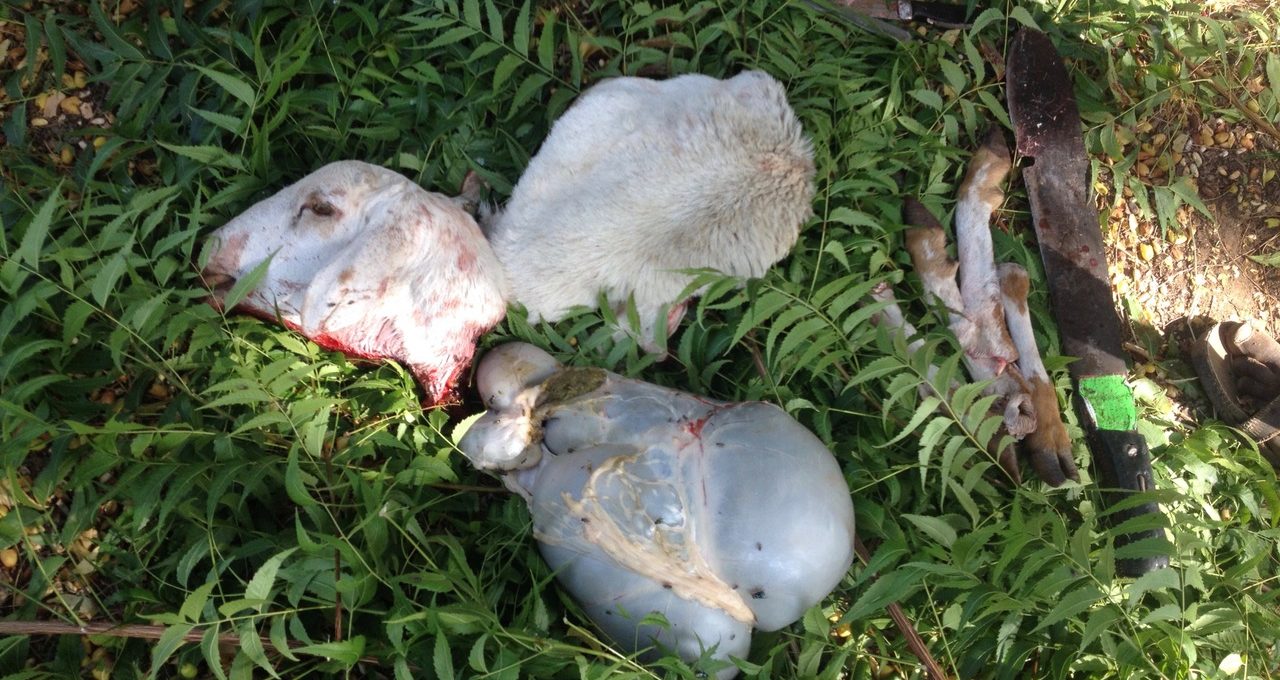“Are you having sheep in your place?”
“No, there are no sheep on my side. You should ask Akol. He is the one managing that species.”
And thus began my search for an Easter lamb. I had seen them grazing in the fields around our home, so I thought it would be easy. Three people later, and only two days until our Easter celebration, I still did not have a lamb. I was beginning to give the idea up, when I spotted the herd again walking straight through our open air church. I jumped on the opportunity, called for the shepherd boy and told him to send the owner to my house so we could negotiate a price. That afternoon they appeared and were told by our workers to come back with the specimen.
I had no experience in preparing, butchering, cooking or even much in eating lamb. I did some internet research on the best type of animal, cuts of meat and recipes. I had asked for a lamb, what showed up at my door step had “only had one baby”. Our employees were ecstatic that the animal was entirely white. I laughed at the initial price, as is my custom when I know they’re trying to fleece the white woman. After a cordial exchange we came to an agreement. Then I had to figure out how to keep it until Easter! We put it in an old chicken cage and fed it grass picked from the fields. It was quieter than its previous occupants. All of the mission children came to see it. I was careful to tell Carmel not to get attached.
When the day came, my friend who had agreed to slaughter it for me was nowhere to be found. I toyed with the idea of doing it myself, but the reality that I really had no idea how got the better of me. I roped in a nearly blind employee and an old man to do the dirty work. They slung it up on a tree branch and deftly cut its throat. They caught the blood in a saucepan and began to methodically skin and butcher the animal. Papa Daudi, the old man, had carefully laid out a bed of neem leaves. He placed the head down gently, then the stomach, the skin, the feet and finally wiped the knives clean in the green foliage. The other parts were separated and placed in buckets for distribution. I had no desire to eat the innards, except the heart and liver, so the employees were ecstatic. The major outer difference between the type of sheep and goats found here is the tail. The tail of a sheep is almost entirely fat, and a local delicacy. Papa Daudi would take home the skin and head.
Emmy, the other employee who helped, laughed his way through the process. The others were scoffing at his ignorance, wondering how he could be a Karimojong and not know how to slaughter. He relayed a local superstition that was apparently new to him; women do not eat the sheep’s stomach because it makes their husband an unfaithful wanderer. He was a willing helper, despite his bad eyesight.
When I picked up the bucket of meat and bones, I wondered where in the world I got the idea! I don’t know how to roast lamb or how to properly trim and cut the appropriate pieces, how to remove (or even identify) the fell, butterfly a leg or French a rack. What was I thinking?! I spent the day attempting to do these very things. I took consolation in bulbs of garlic and freshly chopped rosemary, added a red wine gravy and lemon, caper, mint salsa just in case. I gave it time, to salt, to marinate, to roast low and slow.
Evening came and it was time to carve the meat, what little there was. It seemed to disappear as I cut it from the bone. I had only cooked three of the legs thinking those were the largest and best cuts of meat. It barely filled a small platter. Then I took a bite. I was mesmerized! This was not the mutton I remembered from my childhood with mint jelly on the side. This was a tender, mild meat brought to life by the accompanying flavors!
As you might imagine, we had lamb loins for lunch the following day, grilled in a cocoa-pepper rub, and lamb neck and sirloin the day after that in a Basque tomato stew and I still have one shoulder left, but it is waiting patiently in the freezer.
All of you know where the idea came from. Jesus ate lamb at the Last Supper. He is called the Lamb of God, the lamb led to slaughter a sacrifice for our sins. Now we are able to celebrate His sacrifice because it was followed by His resurrection. Now we eat lamb because it reminds us of our salvation!
